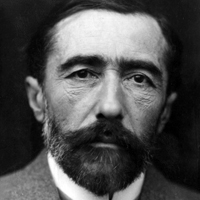Use of Narrative Technique in Heart of Darkness
Joseph Conrad used frame narrative in Heart of Darkness under the influence of the medieval tale telling poets such as Geoffrey Chaucer and Boccaccio. The device of frame narrative which is also known as narrative within narrative has become one new technique for Conrad to narrate his story to the readers.

Joseph Conrad (1857-1924)
The narrator in this technique does not involve himself in the events, but keeps himself at a distance so as to observe all the accounts of the characters and delivers it to us. The two narrators go on describing the events one after another, interweaving all the incidents. In frame narrative, one narrator makes frame by introducing and explaining the events at the beginning, then handing over the narrative to another narrator and at last again resuming the narrative himself. The first narrator remains apart, but still he is with the crew members and is one of them.
In Heart of Darkness the first narrator remains anonymous and according to some critics, the anonymous narrator is the author himself. So, in that sense, Conrad is the first narrator and he narrates in such a way that sometime his identities merge with the second narrator, Marlow. The first narrator's introduction gives entry to the central issues that Marlow is going to deal with in the rest of his narrative: the gloomy role of the city as a center of civilization, the nature of imperialism, an individual's ability to explore one's mind and reach to the core of the subconscious. The author has excellently used poetic language to give the clearest view of physical setting and the effects of outer setting to the inner landscape of Africa.
The whole narrative is divided into three chapters and it is interesting that the each shift from one chapter to another ends in the crucial moment in Marlow’s approach to Kurtz. At the first break, Marlow just hears about Kurtz and becomes eager to see him thinking that he might be an idealist. From this point, the narrative is carried further by Marlow. At the second shift, he becomes too curious about Kurtz just before discovering about his real truth. This, each pause and shift have significant value in the narrative demanding listener’s attention and their reaction upon the incident. From here, the rest of the responsibility of the narrative is taken by the first anonymous narrator.
According to Edward Said in his book titled Joseph Conrad and the Fiction of Autobiography, 1966, p viii, Conrad has used ‘retrospective method’ to convey what he could not mediate upon at the time of the experience. In the course of the narrative, Marlow moves back and forth to introduce past in order to understand the present and the interrelationship of past and present.
Literary Spotlight
Introduction of Heart of Darkness
Exploration of Evil in Heart of Darkness
Kurtz's fall in Heart of Darkness
Relation between Colonizer and Colonized
Symbolism of Light and Darkness in Heart of Darkness
Heart of Darkness is Essentially a Journey Within
Use of Irony in Heart of Darkness
Significance of the Title Heart of Darkness
 |
bachelorandmaster.com |